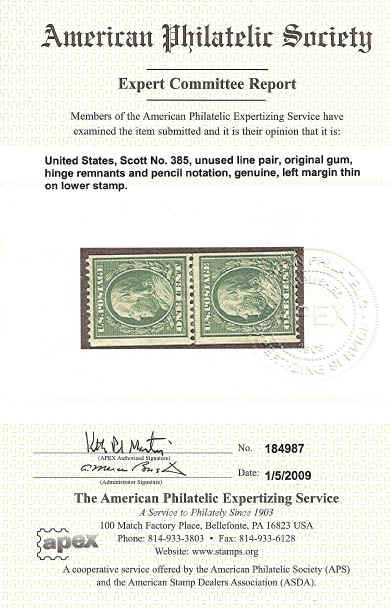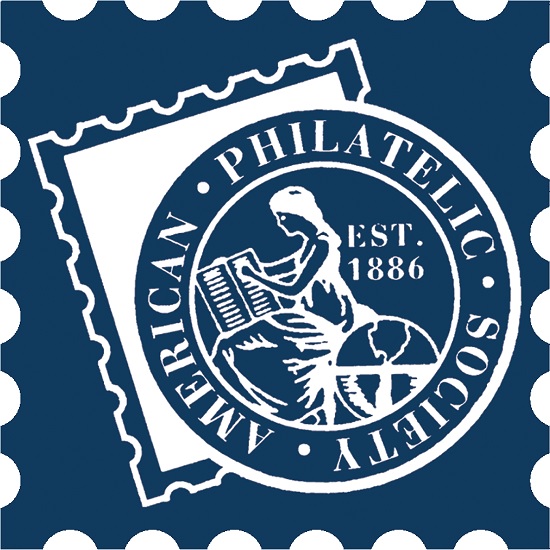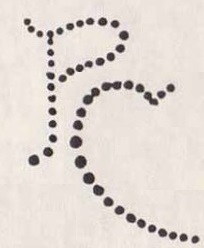Riverside Stamps

Return to Home Page or Altered and Faked stamps Index Page
|
The contents of
this website is copyright protected. Any suggestions for additions or changes are always welcome. |
Suspect Scott #385 Guideline Pair.
Update! The A.P.S. certifies that it is a genuine #385
This is an analysis if of a suspected Scott #385 Guideline Pair (Catalog value: $450.00) that I had found in a box lot that I had bought at auction at the beginning of the year. When I first looked at this stamp I concluded that it was a fake - most likely a Scott #374 with trimmed sides or a Scott #374A booklet pair with the right edge trimmed. At that point I labeled it as such and put it away with the ever growing collection of suspect fake and altered stamps.
I paid no attention to the pair until I purchased a copy of "The Experts Book, a practical guide to the authentication of United States stamps - Washington/Franklin Issues 1908 - 1923" written by Paul W. Schmid (The Experts Book). It was then that I decided to use the information in the The Experts Book to determine for a fact that what I had was a fake. As I started going through the steps in the authentication process I began to have doubts that the pair was a fake and quite possibly be a genuine guideline pair. What follows is the step by step process laid out in The Experts Book along with the results I have gotten for each step.
Determine what the stamp appears to be:
At a quick glance the pair appears to be a Franklin 'ONE CENT' coil perforated 12 horizontally with a single line watermark and a guide line. This would make it a Scott #385 and has a catalog value of $450. According to the book this coil is often faked and can be made from four other stamps by either trimming perforations or adding perforations to Scott #383, #383E, #374 and #374a.
Coil Size:
I measured the width of the two stamps using the mm scale Sonic Imagery Labs Precision U.S. Specialty Multi-Gauge and got a reading of just over 21.0mm which is consistent from top to bottom. According to the book vertical coils usually measure 21.5mm wide but can be as much as +/- 0.3mm off. I'm going to take this pair into where I work and see if I can measure the width with a little more precision. Below are magnified images of the stamps under the Multi-Gauge mm scale.
The cut edges of the pair compare favorably with a genuine cut edge. The pairs edges have the same beveled appearance and softness that the genuine edge has. A magnified image of the cut edges is seen below. The edge on the right is the suspected #385.
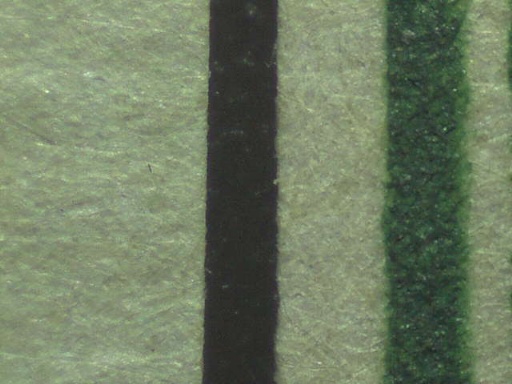
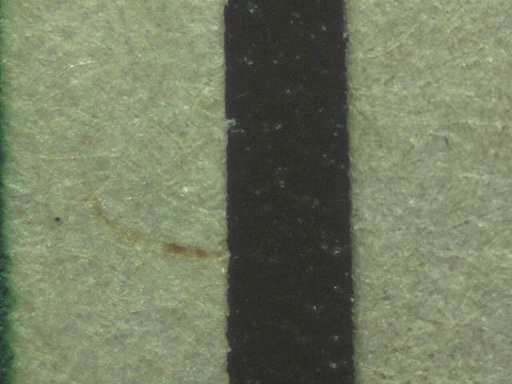
Perforations:
All three sets of perforations on the coil pair gauge out to the required 11.9 when looked at with the Sonic Imagery Labs Precision U.S. Specialty Multi-Gauge and an "Instanta" gauge. Below are magnified images of the perforations under the Multi-Gauge perf gauge.
I had to turn the stamp upside down to have better control of the stamp under the gauge.
here are the center perforations are under the "Instanta" gauge.

The perforations themselves appear to be genuine -
|
The holes all have a slight oval shape, the tips on the top and bottom perforations all have the correct tufts of random pulled fibers, the ragged edges of the center perforations are all on the same place on the left edge of the hole. |
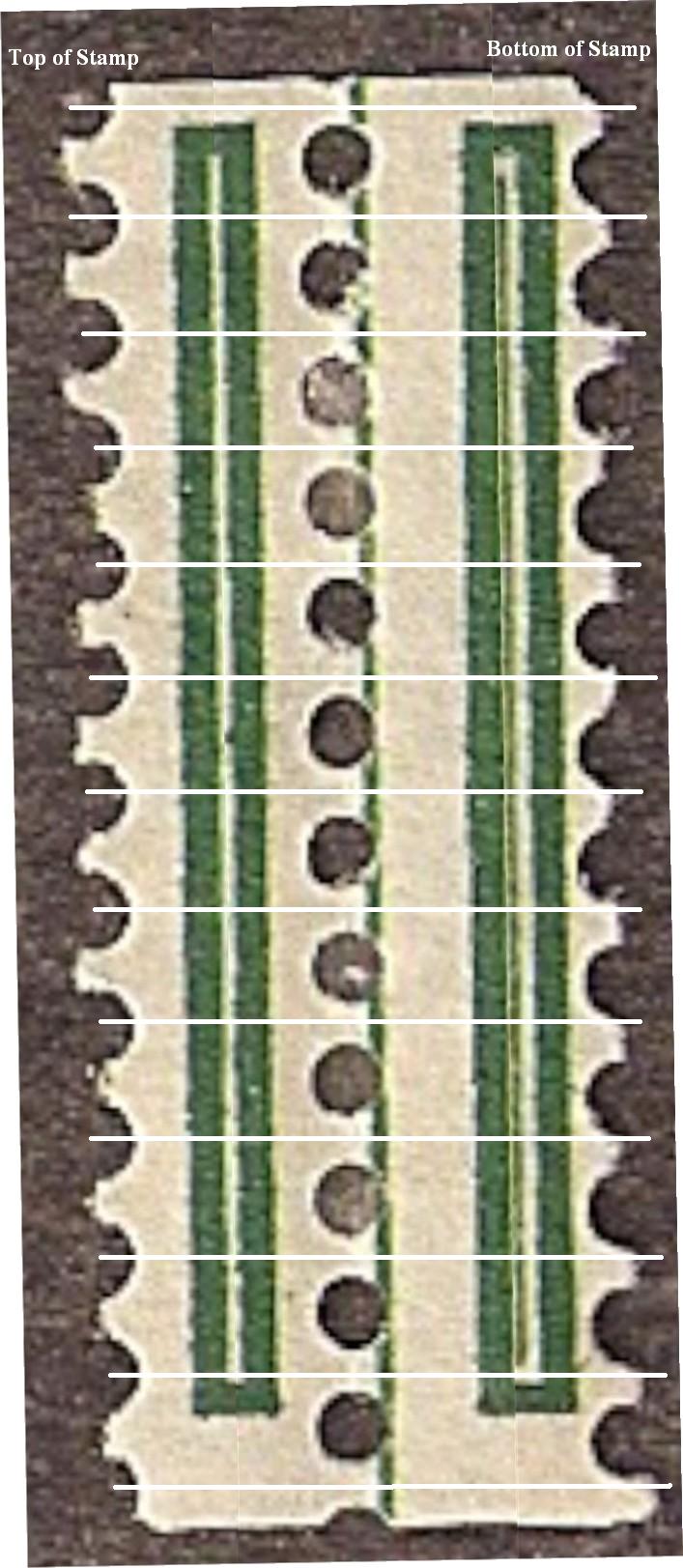
The alignment of the three rows of perf holes is off slightly from row to row, the spacing between the perforations is consistent and they do not vary from side to side. |
The Watermark:
The watermark on the pair is single line, horizontal and reversed - meaning that the watermark, as seen from the back, reads properly from left to right but if seen from the front they would read from right to left thus reversed.
This eliminates any possibility that this pair was manufactured from a #374a booklet pair because the watermark on the booklet would be vertical and read from top to bottom.
The Guideline:
The guide line is the last item to verify and it is not an easy thing to do. Short of using expensive height measuring devices or 3D laser scanners the best way of checking a guide line to see if it is engraved or not is to use cheap thin aluminum foil. The foil I used came from a hair salon and was originally used to separate hair when it is being colored. The best way I found to use foil is to lay the stamp onto a hard smooth surface then place the foil on top of the area in question and use your fingers to stabilize the foil and stamp - neither one can move or the impression will be ruined. Then using the butt end of a well used pencil eraser gently tap the foil in a gentle up and down motion much like if you were stenciling. This forces the foil to take on the contours of the stamp and if the guide line is genuine it will be engraved like the rest of the stamp image and will form a bump on the foil. When finished take the foil impression and look at it in a glancing angle under a lamp and the guideline should be quite noticeable - see the image below.
Compare this image with the image of the pair at the top of the page and you can plainly see the guideline running across the bottom of the perforations.
The Experts Book makes the following statement (Pg 111, section VI part C)
"Vertical Pairs with Horizontal Guidelines. If it can be determined that the perforations and guideline are genuine the following holds true: Sc.#'s: 348, 349, 385, 386. Genuine only if watermarked horizontally (those with vertical watermarks have been made from booklet panes)."
In conclusion I can be reasonably assured that all aspects of this pair from the coil size, the perforations, the guideline, watermark etc make this a genuine Scott #385 guideline pair. I will be sending this stamp off to the A.P.S. to be expertized.
Reference material used:
- The Expert's Book. A practical guide to the authentication of United States stamps. By Paul W. Schmid.
- How to Detect Damaged, Altered and Repaired Stamps. By Paul Schmid
As always comments and suggestions are always welcome.
To Contact Riverside Stamps:
Email:
Mike Girard - Owner / Operator / Web Master:
g1rardmn1099@comcast.net
|
I am a member of the American Philatelic Society
|
I am a member of the United States Stamp Society  USSS #: 16733 Visit the United States Stamp Society Website at www.usstamps.org |
I am a member of the Perfins Club
|

